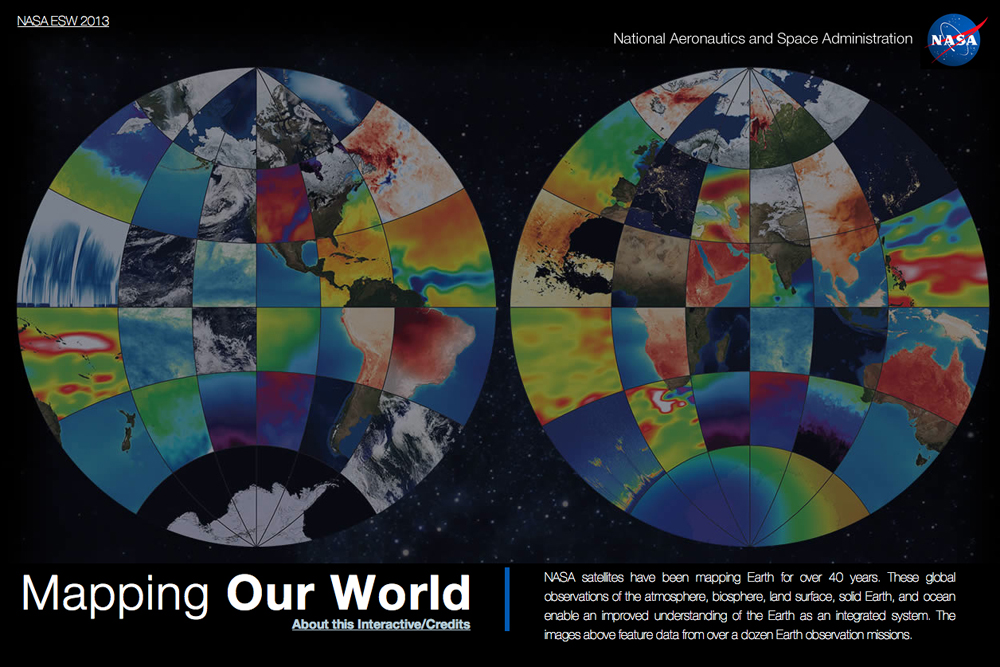
NASA Interactive Reveals New Earth Perspectives (Op-Ed)

Laura Delgado López is the Earth observations associate at the Arlington, Va., Institute for Global Environmental Strategies, and a member of the NASA Earth Science Week Planning Team. She contributed this article to LiveScience's Expert Voices: Op-Ed & Insights.
Before weather radar maps, Google Earth, or handheld GPS devices, many people thought the ink on maps was dry. Today, however, the integration of location technologies, visualization techniques and numerous data points show the world in new ways, and more importantly, reveal that the Earth is always changing.
Environmental changes, both small and monumental, are transforming familiar locations and shifting people's mental images of certain places, reminders of the connection between locations thousands of miles apart.
Through the use of space-, air- and ground-based observations, the National Aeronautics and Space Administration (NASA) is helping keep track of what is going on. Maps are key tools in this effort, allowing scientists to visualize the changes and explore them over time and across dimensions in a way that enthralls even those individuals working in the field of Earth observations.
For example, near India, anyone can now see the impact of the south-Asia monsoon rains on sea surface salinity, or trace the outline of major cities in Japan with a view of Earth at night, or even explore changes in underground water storage in the Middle East with data that span decades.
A new NASA interactive tool brings together 25 different views of our planet to allow people to examine maps like those. In a simple interface, the Mapping Our World interactive offers a sample of some of the information the space agency collects with its 16 Earth observation satellites — from true-color views captured by the flagship Earth-observation mission Terra (launched nearly 15 years ago), to a global map showing rainfall as collected by a 1997-launched U.S.-Japanese satellite called the Tropical Rainfall Measuring Mission (TRMM).

The interactive, just released on the NASA Earth Science Week (ESW) 2013 website, was developed as part of NASA's celebration of Earth Science Week, an annual initiative aimed at raising awareness of the study of the planet and hosted by the American Geosciences Institute since 1998.
Get the Space.com Newsletter
Breaking space news, the latest updates on rocket launches, skywatching events and more!
Under the theme Mapping Our World, this year's celebration encourages people to explore the role of mapping technologies in helping scientists study and understand the planet, and provides an invaluable tool to explain complex phenomena.
"We all see the world as maps," said former astronaut Piers Sellers, deputy director of the Science and Exploration Directorate at NASA's Goddard Spaceflight Center, in a recent interview that will be featured soon on the ESW website. "It's the way people have been trained to visualize how things look and how they change, and the rate of change," he added, explaining the power of the time-series of maps of the ozone hole over Antarctica in communicating the importance of the issue in the '80s and '90s.
Maps can often make complex phenomena click in people's minds, so NASA Earth scientists often use them to understand data collected by satellites and other platforms and to communicate important results to the public. Through thousands of images, animations and visualizations, designers and scientists can combine years — and even decades — of data to sample every aspect of the planet.
The results are not just beautiful and inspiring, but also incredibly important — many of society's decisions depend on the ability to map, understand and sometimes, predict environmental changes taking place. NASA's HS3 mission, for example, uses two unmanned aircraft to take close measurements of hurricanes with a goal of helping improve understanding of changes in hurricane intensity. As evidenced by Superstorm Sandy, being able to accurately predict the intensity of a storm allows coastal communities to make critical decisions that can protect lives and property ahead of time.
NASA Earth scientists have collected unique mapping stories like these about the interactions between Earth's air, land, water, ice and life — some of which may not be familiar to most people. By exploring the new Mapping Our World interactive, children and adults get a glimpse of how NASA maps the Earth and help its residents view the world differently — and ultimately better.
You might never look at a map the same way again.
This story was provided by LiveScience, a sister site to SPACE.com. The views expressed are those of the author and do not necessarily reflect the views of the publisher. This version of the article was originally published on LiveScience.
Join our Space Forums to keep talking space on the latest missions, night sky and more! And if you have a news tip, correction or comment, let us know at: community@space.com.









